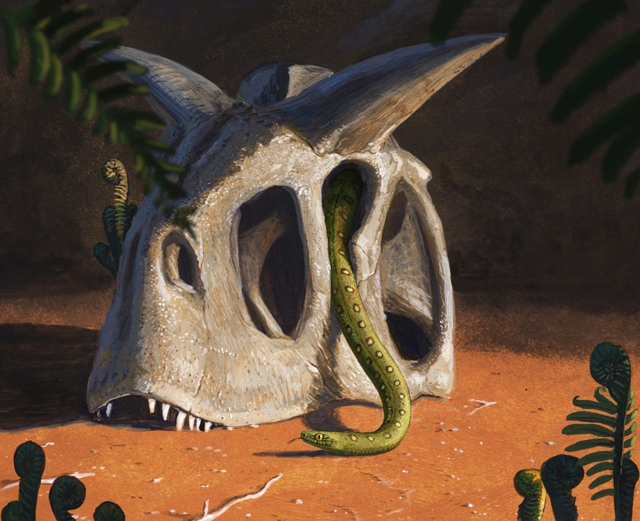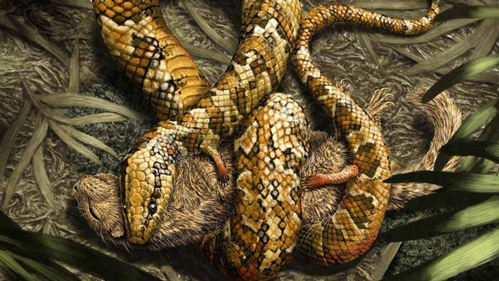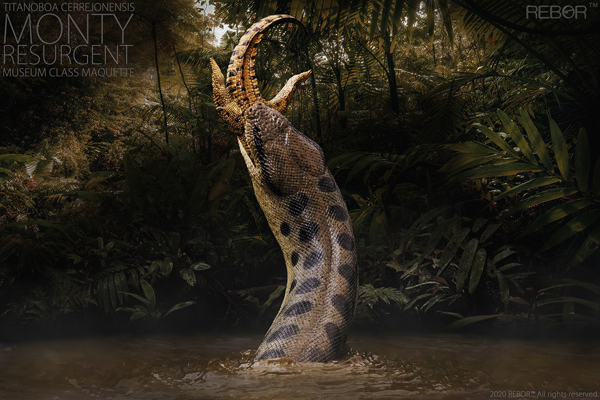New research published in the journal “Nature Communications” suggests that all extant snakes evolved from just a handful of species that survived the K-Pg extinction event 66 million years ago. The researchers conclude that this catastrophic extinction event, that wiped out the non-avian dinosaurs and something like 75% of all terrestrial life, was a form of “creative destruction” leading to a burst of evolutionary development within the Serpentes.

Snakes benefited from the extinction event, the loss of so many competitors allowed them to diversify rapidly and to occupy new niches in food chains.
The Snake Fossil Record
The fossil record of snakes is relatively poor because snake skeletons are typically small and fragile making the preservation of fossil material a rare event.
It is generally accepted that snakes (Suborder Serpentes), evolved from lizards. Snakes gradually losing their limbs, whether the first snakes were burrowers and evolved from burrowing lizards or whether the first snakes were adapted to a life in marine environments is an area of on-going debate between vertebrate palaeontologists. For example, in 2016 a team of scientists challenged the conclusions from the paper that described Tetrapodophis amplectus, a primitive snake-like animal from the Lower Cretaceous of Brazil. It had been suggested that T. amplectus, which had been described and named the year before, was adapted to a life underground, however, researchers from Canada and Australia challenged this view and proposed a marine habit for this 20 cm long animal that has been classified as being close to the base of the evolutionary lineage of true snakes.

To read more about this research: Were the Very First Snakes Marine Reptiles?
Studying Fossils and the Genomes of Living Snakes
The research, led by scientists at the University of Bath in collaboration with researchers from Cambridge, Bristol and Germany, involved examining snake fossils and an analysis of the genomes of living snakes to pinpoint genetic differences permitting a picture of modern snake evolution to be built up.
The results indicate that despite the great variety of snakes alive today – cobras, vipers, pythons, boas, sea snakes and blind, burrowing snakes for example, all extant snakes can be traced back to a handful of species that survived the K-Pg extinction event that took place 66 million years ago.
Snake Survival Strategy
The authors postulate that the ability of snakes to shelter underground and go for long periods without food helped them survive the destructive effects of the bolide impact event. In the aftermath, the extinction of their competitors including Cretaceous snakes and small theropod dinosaurs, permitted snakes to move into new niches, new habitats and new parts of the world. Today, snakes are found in all but the highest latitudes and are present on every continent except Antarctica.
The researchers, which included lead author Dr Catherine Klein, a former graduate of Bath University but now based at the Alexander-Universität Erlangen-Nürnberg (FAU) in Germany, state that modern snake diversity – including tree snakes, sea snakes, venomous vipers and cobras, and huge constrictors like boas and pythons – emerged only after the non-avian dinosaur extinction.
Dr Klein commented:
“It’s remarkable, because not only are they surviving an extinction that wipes out so many other animals, but within a few million years they are innovating, using their habitats in new ways.”
A Change in Snake Vertebrae
Fossils also show a change in the shape of snake vertebrae in the aftermath, resulting from the extinction of Cretaceous lineages and the appearance of new groups, including giant sea snakes, such as Gigantophis garstini from the Eocene of northern Africa which may have reached a length of ten metres. Gigantophis was scientifically described in 1901, it was thought to have been the largest snake to have ever lived, until in 2009 when the giant, South American boa – Titanoboa cerrejonensis was described.

The picture (above) shows the Rebor Titanoboa Museum Class Maquette known as Monty Resurgent.
To view the Rebor range of models and figures: Rebor Prehistoric Animal Models.
Rapidly Spreading Around the Globe
The research team also suggest that snakes began to spread rapidly around the globe. The “Greenhouse Earth” conditions that occurred close to the boundary between the Palaeocene and Eocene Epochs that led to the establishment of extensive tropical forests in the Northern Hemisphere, would have facilitated the geographical spread of cold-blooded animals such as snakes.
Although the ancestor of living snakes probably lived somewhere in the Southern Hemisphere, snakes first appear to have spread to Asia after the extinction event.
Corresponding author, Dr Nick Longrich, from the Milner Centre for Evolution (University of Bath), explained:
“Our research suggests that extinction acted as a form of “creative destruction”- by wiping out old species, it allowed survivors to exploit the gaps in the ecosystem, experimenting with new lifestyles and habitats. This seems to be a general feature of evolution – it’s the periods immediately after major extinctions where we see evolution at its most wildly experimental and innovative. The destruction of biodiversity makes room for new things to emerge and colonise new landmasses. Ultimately life becomes even more diverse than before.”
Further Serpentes Evolution Driven by Climate Change
The researchers also found evidence for a second major diversification event around the time that the world shifted from a warm and moist climate to a colder, more seasonal climate (Oligocene Epoch).
It seems, that for the snakes at least, global catastrophes can have their upsides. The patterns seen in snake evolution hint at the key role played by mass extinction events – they are the catalysts for driving rapid evolutionary changes.
The scientific paper: “Evolution and dispersal of snakes across the Cretaceous-Paleogene mass extinction” by Catherine G. Klein, Davide Pisani, Daniel J. Field, Rebecca Lakin, Matthew A. Wills and Nicholas R. Longrich published in Nature Communications.






Leave A Comment